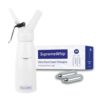The Environmental Impact of Nitrous Oxide Whipped Cream Chargers
Introduction
In recent years, the popularity of whipped cream chargers-- typically described as N2O or nitrous oxide chargers-- has actually surged in both business and domestic settings. These small cylinders, commonly used with whipped cream dispensers, develop fluffy, tasty whipped cream in seconds. However, the ecological impact of nitrous oxide whipped cream chargers is a subject that requires careful factor to consider. This post will explore the various ramifications of nitrous oxide usage in whipped cream chargers, including its contribution to greenhouse gas emissions, potential alternatives, and sustainable practices.
The Ecological Impact of Nitrous Oxide Whipped Cream Chargers
Nitrous oxide (N2O) is a potent greenhouse gas understood for its lasting effects on climate change. Released into the environment through numerous human activities-- consisting of agriculture and industrial processes-- this gas has gained attention for its role in international warming. The ecological effect of nitrous oxide whipped cream chargers may seem minimal compared to larger markets, yet it contributes substantially to the cumulative impacts of greenhouse gases.
Understanding Nitrous Oxide (N2O)
Nitrous oxide is not just any gas; it is a colorless and odor-free compound that has actually found numerous applications across varied fields such as medication, food preparation, and even automobile performance. In terms of its effectiveness as a greenhouse gas, N2O has to do with 298 times more efficient than carbon dioxide over a 100-year duration. This staggering figure makes comprehending its sources and effects crucial.
Where Does Nitrous Oxide Come From?
-
Agricultural Practices: Among the primary sources of N2O emissions is agricultural soil management practices.
-
Industrial Processes: Production processes in markets likewise contribute to N2O emissions.
-
Waste Management: Land fills launch N2O during the breakdown of natural materials.
The intro of whipped cream chargers into this mix adds a new dimension to our understanding of nitrous oxide emissions.

Whipped Cream Chargers: A Closer Look
Whipped cream chargers are small metal canisters filled with nitrous oxide. When paired with a whipped cream dispenser, they make it possible for users to produce newly whipped cream easily. While these tools offer benefit and enhance cooking experiences at celebrations and restaurants alike, what are their implications for our environment?
How Do Whipped Cream Chargers Work?
Filling the Dispenser: The charger is inserted into a specifically created whipped cream dispenser.
Releasing Nitrous Oxide: When triggered, N2O is launched into the dispenser.
Creating Whipped Cream: The pressure forces heavy light whipping cream through a nozzle, aerating it into fluffy whipped cream.
While this process appears simple and harmless, one should think about the lifecycle impact-- from production to disposal-- of these chargers.
Greenhouse Gas Emissions from Whipped Cream Chargers
The environmental effect of nitrous oxide whipped cream chargers can be measured by assessing their contributions to greenhouse gas emissions throughout their life process:
-
Production Emissions: Production metal canisters requires energy-intensive processes.
-
Transport Emissions: Delivering these items contributes even more to their carbon footprint.

-
Usage Emissions: Each charger launches roughly 8 grams of N2O when used.
Comparative Analysis: N2O vs CO2 Emissions
|Activity|CO2 Emissions (g)|N2O Emissions (g)|| ------------------------------|--------------------|--------------------|| Manufacturing (per battery charger)|5|0.1|| Disposal|0|Varies|
This table highlights not just the direct emissions connected with each activity however likewise highlights how seemingly benign practices can collect substantial environmental expenses over time.
Alternative Techniques for Developing Whipped Cream
Given the ecological ramifications connected with nitrous oxide use in whipped cream chargers, what alternatives exist?
1. Manual Whipping
Using a whisk or electric mixer allows users to whip heavy cream without counting on charged containers. While this technique might need more time and effort, it eliminates unneeded greenhouse gas emissions entirely.
2. Pumping Systems
Some manufacturers have begun introducing manual pumping systems that use air instead of nitrous oxide to aerate creams. These systems allow for comparable outcomes without contributing extra greenhouse gases.
Sustainable Practices for Utilizing Whipped Cream Chargers
If switching away from nitrous oxide isn't practical for your kitchen area or company setup just yet, embracing sustainable practices could help mitigate some unfavorable impacts related to utilizing whipped cream chargers:
1. Accountable Sourcing
Look for providers who prioritize sustainability in their production procedures-- those that utilize recycled materials or energy-efficient approaches contribute less total pollution.
2. Recycling Utilized Chargers
Many areas have recycling programs particularly targeting metal canisters like those utilized in whipped cream chargers. Appropriately dealing with or recycling these items minimizes landfill waste significantly.
3. Educating Customers About Use Limits
Encouraging consumers not to overuse these items assists reduce waste related to single-use products while still taking pleasure in delicious creations.
FAQ Section
Q1: What are whipped cream chargers made from?
A1: Whipped cream chargers are normally made from stainless-steel or aluminum and contain nitrous oxide (N2O).

Q2: Are there health dangers connected with breathing in nitrous oxide?
A2: Yes! Inhaling nitrous oxide recreationally can lead to serious health issues consisting of oxygen deprivation due to displacement of air in lungs; prolonged direct exposure can damage nerves as well.
Q3: Can I recycle my utilized whipped cream charger?
A3: Yes! Numerous locations accept metal cylinders like those utilized in whipped cream charges for recycling functions; check regional guidelines for specifics!
Q4: Just how much nitrous oxide is launched per charger?
A4: Each basic charger releases roughly 8 grams of nitrous oxide when used properly!
Q5: Exist eco-friendly options available?
A5: Yes! Manual whipping approaches or more recent air-pumping systems use practical alternatives that do not rely on compressed gases for aeration purposes!
Q6: What's being done worldwide relating to nitrogen emissions?
A6: Numerous nations are enacting more stringent policies around nitrogen emissions in farming & & industry; researchers continually seek ingenious solutions like nitrification inhibitors!
Conclusion
While indulging in delightful treats topped with fresh whip from powered dispensers remains popular amongst lots of customers today-- the wider picture reveals worrying realities looped through an invisible thread called "nitrogen." Understanding The https://s3.us-east-005.backblazeb2.com/nibblegravingsnow/cream-chargers/from-amateur-to-pro-mastering-cream-charger-strategies.html Ecological Effect of Nitrous Oxide Whipped Cream Chargers needs us all engaging seriously about our options surrounding food preparation equipment while looking for sustainable courses forward anywhere possible! By going with more eco-friendly methods or properly sourcing ingredients/products we stand much better possibility at protecting precious environments moving into future generations ahead!
This short article serves as an exploration into both joys & & responsibilities linked within culinary world in the middle of increasing issues surrounding environment modification; eventually motivating readers toward informed decisions every step along way!
